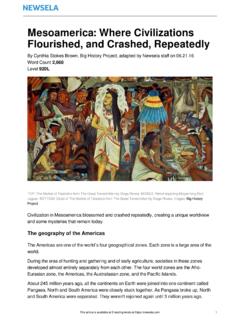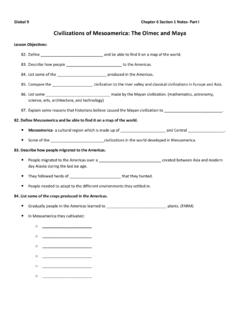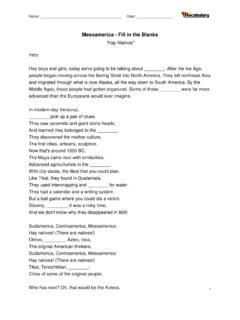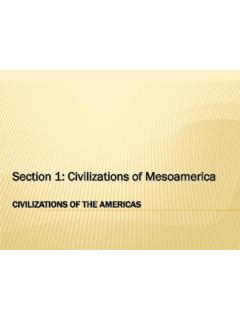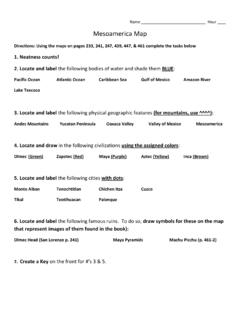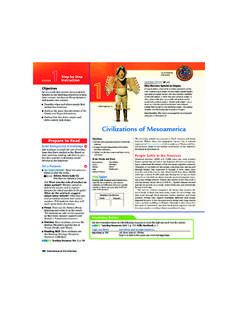Transcription of Mesoamerica: Where Civilizations Flourished, and Crashed ...
1 mesoamerica : Where CivilizationsFlourished, and Crashed , RepeatedlyTOP: The Market of Tlatelolco from The Great Tenochtitlan by Diego Rivera. MIDDLE: Relief depicting Mayan king Bird-Jaguar. BOTTOM: Detail of The Market of Tlatelolco from The Great Tenochtitlan by Diego Rivera. Images: Big HistoryProject In mesoamerica , civilization rose and fell several times. This pattern shaped how people livingthere viewed the world. It also led to some mysteries still unsolved geography of the AmericasThe Americas are one of the world s four big geographical areas. The others are the Afro-Eurasian zone, the Australasian zone, and the Pacific Islands. Early human societiesdeveloped in these areas apart from each 245 million years ago, the Earth's continents were all joined together. Thissupercontinent was called Pangaea. As Pangaea broke up, North and South Americaseparated.
2 They were not rejoined until 3 million years Cynthia Stokes Brown, Big History Project, adapted by Newsela staff on Word Count 984 Level 690L This article is available at 5 reading levels at , North and South America are connected by a narrow strip of land. This piece of land isknown as the Isthmus of Panama. Most societies in mesoamerica developed just north of theIsthmus of OlmecsThe founding society of mesoamerica was the Olmecs. Their society emerged in river valleysalong the Gulf of Mexico more than 3,000 years Olmecs made art that is still around today. The most famous are huge heads carved outof volcanic rock. Some are more than 10 feet last Olmec city declined about 2,000 years ago. Historians are not sure what led to thedecline. Was it volcanic eruptions? A shift in the flow of rivers? Fighting between the rich andpoor? No one MayaAs the Olmecs declined, their neighbors to the east thrived.
3 The Maya lived in an area calledthe Yucatan Peninsula. It had poor soil and no large rivers. Yet people there grew corn, beans,squash, peppers, and cacao, or article is available at 5 reading levels at Maya did not live in one big kingdom. Instead, they organized themselves into severalsmall city-states. The largest was Tikal, which had about 40,000 people living in it by 750 people were ruled by leaders and had special jobs. Sometimes the city-states fought witheach article is available at 5 reading levels at Maya had an advanced writing system that used symbols. They also invented three kindsof calendars. One calendar was used to keep track of farming cycles. Another was used fordaily activities. The third calendar was called the Long Count calendar. It went back to 3114 BCE and was used to record the longer passing of time. The Maya believed that the world hadended four times already and that they were living in the fifth society changed rapidly between 800 and 925 CE.
4 People left the cities and movedback to the countryside. Historians are not sure why. It may have been because ofearthquakes, drought, or enemy attacks. But the Maya did not just disappear. Several millionare still alive today, and in parts of Mexico they still speak the Mayan the center of Mexico, at about the same time, another amazing city developed calledTeotihuacan (tay-oh-tee-wa-KAHN). It began as an agricultural village near present-dayMexico City. Teotihuacan was located in the highlands of Mexico, more than a mile above sealevel. Water flowing from surrounding mountains created several large lakes in this area. By500 CE, it had more than 100,000 people. It was one of the six largest cities in the world. This article is available at 5 reading levels at and the AztecsMesoamerican civilization reached its height with the Aztecs. They built the great city ofTenochtitlan (the-noch-tee-TLAHN), which means place of the cactus fruit.
5 "The Aztecs came from northern Mexico. By the 1500s, they had conquered most ofMesoamerica. They ruled more than 10 million people, who had to pay them tribute everyyear. The tribute was made up of food and goods, including jewelry, animal skins, society was organized around military leaders, and warriors were highly honored. Theywore fine cloth and feathers. The common people wore clothes made from plant worked the land or served as the Olmecs, the Aztecs used a complicated calendar system. Priests also performedceremonies to honor the gods. The Aztecs believed these ceremonies would stop earthquakesand other fall of the AztecsIn 1520, Spanish fighters led by Hern n Cort s invaded Mexico. They used horses, guns, andswords to defeat the Aztecs in Spanish brought with them a disease called smallpox. The Aztecs had no immunity to it tosave themselves from getting sick.
6 The disease killed many of them, forcing the rest tosurrender. Soon the Spanish controlled all of article is available at 5 reading levels at the Americas to Afro-EurasiaThe Americas did not develop many of the technologies used in Afro-Eurasia. For example,early Americans did not use wheels or melt iron and steel. For blades they used a rock fromvolcanoes called obsidian. They had no swords, guns, or the Americas, people did not travel the long distances that they did in Afro-Eurasia. Afro-Eurasia stretches east to west. People traveling through it stayed in similar climates. TheAmericas stretch north to south. This creates huge changes in climate for travelers. It wasmore difficult for people to trade crops, because the plants would not easily grow in and societies began later in the Americas than they did in Afro-Eurasia. Still, they weresimilar in many ways.
7 It is likely that the American societies would have continued if they hadnot been destroyed by the and geography allowed the Europeans to conquer the people of the Americas. TheEuropeans also took many Africans as slaves to work in the Americas. What followed is adisturbing story, but one that helped make the modern article is available at 5 reading levels at
